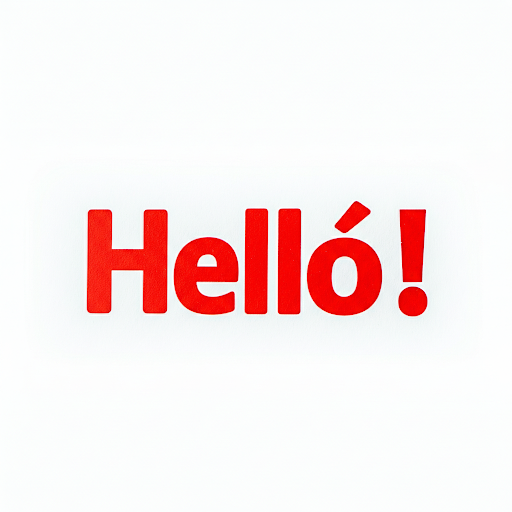
How to Say Hello in Hungarian with Hello Words
Share
How to Say Hello in Hungarian: Greetings and Phrases You Need to Know
Common Ways to Say Hello in Hungarian
In Hungarian, just like in any language, greetings are an important part of conversation. Whether you’re visiting Hungary or learning the language, knowing how to say “hello” can make a big impression. Here are some of the most common ways to say hello in Hungarian:
- Helló: This is the most straightforward and widely used greeting. It's informal and commonly used among friends, family, and peers.
- Szia This is the most used informal.
- Szervus This is the most used with close family or close friends.
- Jó napot or Jó napot kívánok: These ways are more formal ways to say "Good day" and is typically used in professional or respectful settings.
- Sziasztok: This is a plural version of Helló and is used when greeting a group of people. It’s informal but friendly.
- Üdvözlöm: Another formal greeting that can be translated as "I greet you"—a polite expression often used in business or official settings.
In Hungary, the level of formality in your greeting depends on the context. If you're in a casual setting, Helló is fine, but for more formal occasions, like at work or with elders, Jó napot kívánok or Üdvözlöm might be more appropriate.
Hungarian Greetings for Different Times of the Day
Much like in English, Hungarians have specific greetings depending on the time of day. Here’s how to say hello based on when you’re greeting someone:
- Jó reggelt!: Good morning. A friendly and polite greeting used in the early hours of the day.
- Jó napot!: Good afternoon. A formal greeting, perfect for use from late morning until the evening.
- Jó estét!: Good evening. Used when greeting someone later in the day or after the sun has set.
These time-specific greetings not only show politeness but also reflect a key part of Hungarian culture—respect for time and punctuality. The way you greet someone often signals your level of respect for the relationship.
Fun Hungarian Phrases for Saying Hello
Hungarians are known for their friendly and warm nature. Here are some fun and informal greetings that will make you sound like a true local:
- Mi újság?: This literally means “What’s new?” and is a casual way to greet someone you know well. It’s the Hungarian equivalent of asking, “How’s it going?”
- Hogy vagy?: This translates to “How are you?” and is a typical question you ask after greeting someone. It’s informal, so you’d use it with friends and acquaintances.
- Na, mi van?: Another informal greeting, this one is often used between friends, similar to saying, “What’s up?” in English.
If you're meeting someone for the first time and want to sound polite, stick with the more formal Jó napot kívánok or Üdvözlöm. But once you’re familiar with Hungarian culture, you can incorporate these fun phrases into your conversations to sound more casual and approachable.
Hungarian Greeting Customs and Etiquette
Greeting customs in Hungary may vary depending on the situation and the people involved. Here are some important cultural points to remember:
- Handshakes: A firm handshake is the standard greeting in professional settings and is often accompanied by a verbal greeting like Jó napot kívánok.
- Respect for Elders: When greeting older people, it’s customary to use formal greetings and titles, such as Ön (you, formal) instead of te (you, informal).
- Kissing on the Cheeks: While not common, some greet only close friends and family with a light kiss on each cheek, starting with the left cheek. This custom is more prevalent in smaller towns and among people who know each other well.
- Greetings in Hungarian Cafes and Restaurants: In Hungarian cafes or restaurants, it's polite to greet the staff with a friendly Jó napot or Helló before placing your order. This shows appreciation for the service staff and is part of the local etiquette.
By understanding and respecting these cultural norms, you can make a great impression and connect with the people you meet in Hungary.
Expand Your Vocabulary: Other Useful Hungarian Phrases
Beyond the standard greetings, it’s useful to learn a few additional Hungarian phrases to continue a conversation. Here are some that will come in handy:
- Viszontlátásra: Goodbye. A polite way to say farewell, often used after a formal conversation.
- Kérem: Please. A word that comes in handy in almost every conversation, particularly when making requests.
- Köszönöm: Thank you. Gratitude is highly valued in Hungary, and it’s important to thank others during interactions.
- Bocsánat: Excuse me. A very useful phrase when you need to apologize or get someone’s attention.
These phrases will help you build a more complete and respectful dialogue with Hungarian speakers. As you get more comfortable with the language, you’ll discover even more expressions that enrich your vocabulary!
Conclusion: Embrace Hungarian Greetings with Confidence
Learning how to say hello in Hungarian is the first step in understanding the culture and building relationships with Hungarian speakers. Whether you're traveling, working, or just connecting with friends, greeting someone in their native language always leaves a positive impression.
Keep practicing these greetings and phrases, and soon enough, you’ll be able to confidently start conversations with anyone you meet in Hungary. For more resources and tips on learning Hungarian, visit Learn Hungarian Anywhere!
